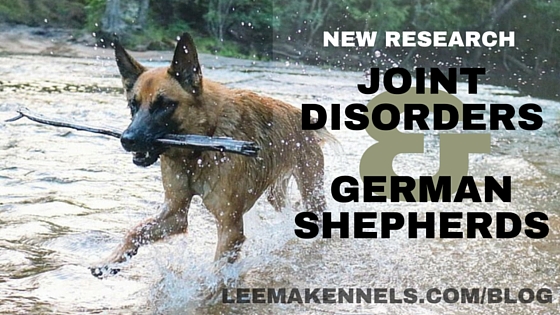New Research on Early Neutered German Shepherds and Joint Disorders

![]() It’s very exciting how there is growing research on desexing in dogs, including age of neutering, and its implications on health. In the past, I have blogged on how desexing in German Shepherds is linked to reactivity. The latest study, published last month, looks at bone disorders, cancers, urinary incontinence, and pyometra in German Shepherds.
It’s very exciting how there is growing research on desexing in dogs, including age of neutering, and its implications on health. In the past, I have blogged on how desexing in German Shepherds is linked to reactivity. The latest study, published last month, looks at bone disorders, cancers, urinary incontinence, and pyometra in German Shepherds.
Many of the arguments for desexing dogs has been around population control instead of health matters – but obviously health does matter. We want dogs to be healthy.
This retrospective study looked at the health of 1170 German Shepherds. It included the analysis of vet records over 14.5 years (2000-2014). For each incidence of disease, the dogs’ records were followed for eight years, except in the case of mammary cancer, which was followed for eleven years. The data on the incidence of joint disorders and cancers in the German Shepherds was compared beside their sexes, and their neuter-age.
Joint Disorders
The biggest problem with early aged desexing in this breed, according to this study, is an increased risk of joint disorders. For example:
- 6.6% of intact males had one or more joint disorders, but for dogs that were desexed before 6 months, 20.8% had one or more joint disorder. So joint disorder incidence was three times greater in dogs desexed before 6 months than intact dogs. For dogs that were desexed between 6-12 months, the incidence of at least one bone disorder was 16.4%.
- Similarly, 5.1% of intact female had one or more joint disorders, but for bitches that were desexed before 6 months the incidence was 12.5%, and for bitches that were desexed at 6-11 months the incidence was 17%.
- Of the joint disorders considered, Cranial Cruciate Ligament Tear was most highly correlated with early desexing. In entire dogs, hip dysplasia was most commonly seen.
- For desexed dogs, rates of hip and elbow dyplasia was greater than entire dogs, but this difference was not statistically significant.
- There was no difference between the body condition scores (i.e. fatness) between entire and neutered populations – so it’s not obesity that has caused these problems.
But why do German Shepherds have an increased incidence of joint disorders when they’re desexed before one year of age?
If a dog is desexed before one year of age, the growth plates of the dog are unlikely to have closed. (That is, the bones are still growing.) With the removal of hormone cues through the removal of gonads, the bones are likely to grow longer than they ‘should’, which disrupts joint alignment. This disruption leads to joint disorders such as those found in this and similar studies.
However, this research did not just look at bone disorders.
Cancer
Unlike previous studies on cancer in other breeds, there was no statistically significant differences between neutered and entire animals. However, in terms of mammary cancer (which was only considered in bitches), 4% of intact females got mammary cancer, but <1% got mammary cancer if desexed before one year of age. The paper notes that mammary cancer seems to be uncommon in German Shepherds and refers to a recent meta-analysis that found the protective factor of neutering in terms of mammary cancer to be weak.
In terms of other cancers there was no significant differences. (My own note though: This study found that only 14% of the entire bitches were used for breeding. Lactating is a protective factor against mammary cancer, so I would suspect that if more of these bitches were breeding bitches, the rate of mammary cancer may have been lower again.)
Bitch-Specific Conditions
Urinary incontinence was seen at a rate of 7% in neutered bitches, but was not seen at all with entire bitches. (Urinary incontinence was not considered in males.) The mean age of onset of urinary incontinence in early neutered females was 5.2 years.
Pyometra in intact females was seen as a rate of 2.5%.
How does this compare to other research?
It’s important to note that this new data adds to our growing understanding of desexing implications. This study references:
- A 2014 study saw that Golden Retrievers and Labrador Retrivers were, generally, more likely to have a joint disorder the earlier they were desexed.
- A 2013 study saw that Golden Retrievers that were early desexed had more hip dysplasia, cranial cruciate ligament tears, and lymphosarcoma. Desexing, regardless of time, increased the rate of at least one cancer by 3-4 times.
- Another 2013 study found that, in Vizslas, the incidence of cancers was high in desexed dogs (except mammary cancer – where incidence was low).
- Another 2013 study found that neutered male and female dogs were more likely to die of cancer than intact dogs.
- A 2011 study that found that, in several breeds, the incidence of mast cell tumours was four times greater in spayed females as opposed to intact.
- A 2008 study that saw that desexing before 12 months of age saw joint disorders (such as hip dysplasia, cranial cruciate ligament tears, and elbow dysplasia) occuring at 2-3 times higher rates than in intact dogs.
- A 2007 study linked early desexing with risk factors for cranial cruciate ligament tears.
- A 1999 study found that cardiac hemangiosarcoma was four times more common in spayed females than those intact.
- A 1998 study, looking at several breeds, saw that osteosarcoma was two times more likely in neutered dog compared to intact dogs.
- A 1988 study that found that splenic hemangiosarcoma was two times more likely in spayed females than intact.
The researchers involved with this study have been adding great data to the neutering/spaying discussion. They have previously published articles on Labrador vs Golden Retrievers and Golden Retrievers, and these articles had similar findings. (Though German Shepherds did not seem to be as cancer prone as the Golden Retrievers.) As all these studies are using vet clinic data, it is not known how similar or dissimilar the strains/lines are – so the sample could be genetically diverse despite being the same breed.
But it seems that, for German Shepherds, it is far better to wait until dogs are twelve months or older before desexing, if desexing is chosen at all. I’ll end on a quote from the paper:
As shown in this study, delaying neutering until the dog is at least a year of age appears to avoid the increase in risks of joint disorders is associated with neutering. This is a consideration for joint disease control that is immediately available.
Reference:
Hart, B., Hart, L., Thigpen, A., & Willits, N. (2016). Neutering of German Shepherd Dogs: associated joint disorders, cancers and urinary incontinence Veterinary Medicine and Science DOI: 10.1002/vms3.34
Further Reading:
Early Neutering Poses Health Risks for German Shepherd Dogs, Study Finds
A Link Between Desexing and Reactivity
Labs and Goldens: Goldens Get Cancer Better

